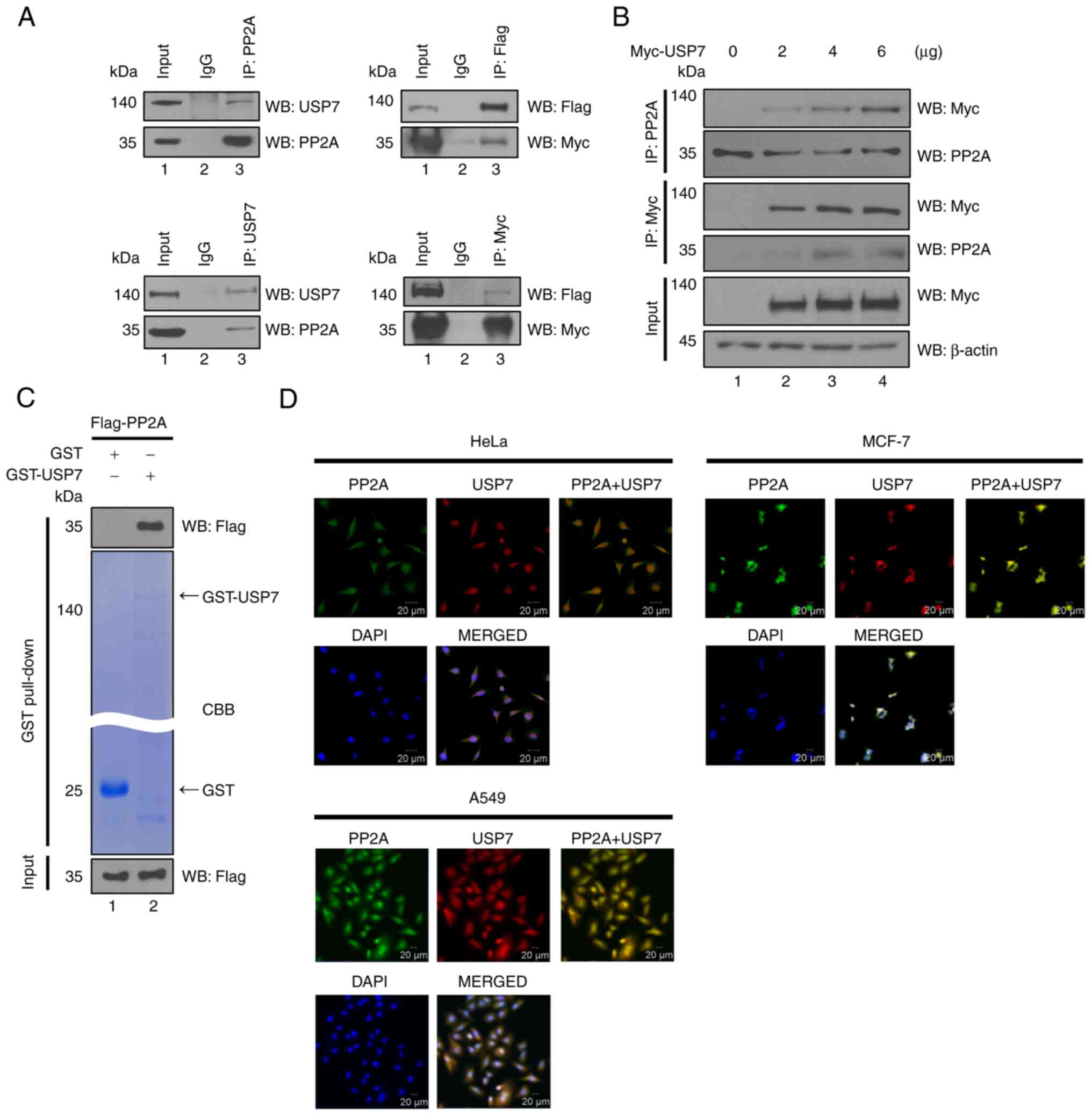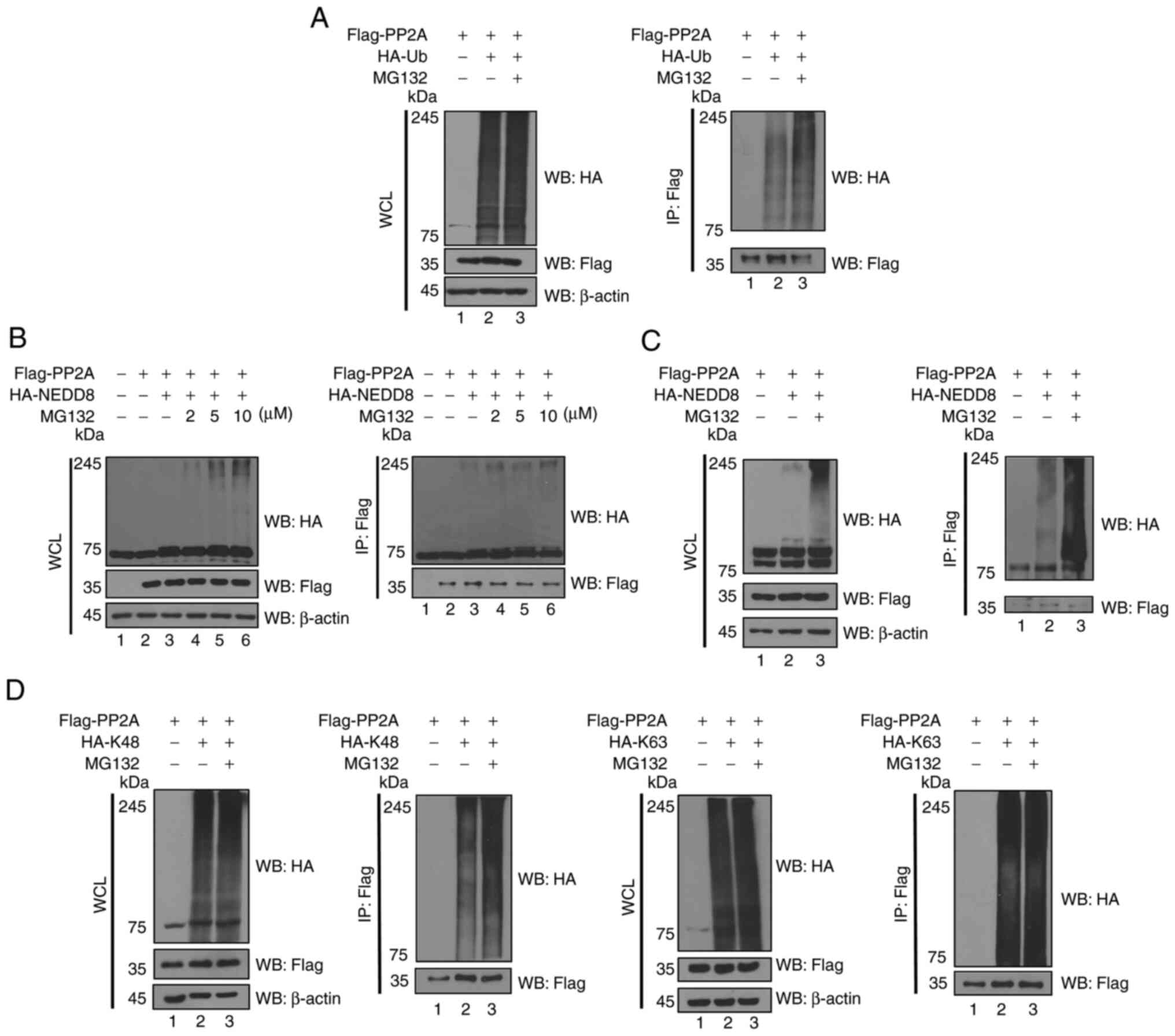|
1
|
Tsuchiya H, Endo A and Saeki Y: Multi-step
ubiquitin decoding mechanism for proteasomal degradation.
Pharmaceuticals (Basel). 13:1282020. View Article : Google Scholar
|
|
2
|
Kim RQ and Sixma TK: Regulation of USP7: A
high incidence of E3 complexes. J Mol Biol. 429:3395–3408. 2017.
View Article : Google Scholar
|
|
3
|
Deng L, Meng T, Chen L, Wei W and Wang P:
The role of ubiquitination in tumorigenesis and targeted drug
discovery. Signal Transduct Target Ther. 5:112020. View Article : Google Scholar : PubMed/NCBI
|
|
4
|
French ME, Koehler CF and Hunter T:
Emerging functions of branched ubiquitin chains. Cell Discov.
7:62021. View Article : Google Scholar : PubMed/NCBI
|
|
5
|
Tracz M and Bialek W: Beyond K48 and K63:
Non-canonical protein ubiquitination. Cell Mol Biol Lett. 26:12021.
View Article : Google Scholar
|
|
6
|
He M, Zhou Z, Shah AA, Zou H, Tao J, Chen
Q and Wan Y: The emerging role of deubiquitinating enzymes in
genomic integrity, diseases, and therapeutics. Cell Biosci.
6:622016. View Article : Google Scholar
|
|
7
|
Zhou X and Sun SC: Targeting ubiquitin
signaling for cancer immunotherapy. Signal Transduct Target Ther.
6:162021. View Article : Google Scholar : PubMed/NCBI
|
|
8
|
Jacomin AC, Taillebourg E and Fauvarque
MO: Deubiquitinating enzymes related to autophagy: New therapeutic
opportunities? Cells. 7:1122018. View Article : Google Scholar
|
|
9
|
Kim SH and Baek KH: Regulation of cancer
metabolism by deubiquitinating enzymes: The Warburg effect. Int J
Mol Sci. 22:61732021. View Article : Google Scholar
|
|
10
|
Ajadi MB, Soremekun OS, Elrashedy AA,
Olotu FA, Kumalo HM and Soliman MES: Probing protein-protein
interactions and druggable site identification: Mechanistic binding
events between ubiquitin and zinc finger with UFM1-specific
peptidase domain protein (ZUFSP). Comb Chem High Throughput Screen.
25:831–837. 2022. View Article : Google Scholar : PubMed/NCBI
|
|
11
|
Kim SY and Baek KH: TGF-β signaling
pathway mediated by deubiquitinating enzymes. Cell Mol Life Sci.
76:653–665. 2019. View Article : Google Scholar
|
|
12
|
Wang Z, Kang W, You Y, Pang J, Ren H, Suo
Z, Liu H and Zheng Y: USP7: Novel drug target in cancer therapy.
Front Pharmacol. 10:4272019. View Article : Google Scholar
|
|
13
|
Lu J, Zhao H, Yu C, Kang Y and Yang X:
Targeting ubiquitin-specific protease 7 (USP7) in cancer: A new
insight to overcome drug resistance. Front Pharmacol.
12:6484912021. View Article : Google Scholar
|
|
14
|
Veggiani G, Gerpe MCR, Sidhu SS and Zhang
W: Emerging drug development technologies targeting ubiquitination
for cancer therapeutics. Pharmacol Ther. 199:139–154. 2019.
View Article : Google Scholar : PubMed/NCBI
|
|
15
|
Nininahazwe L, Liu B, He C, Zhang H and
Chen ZS: The emerging nature of ubiquitin-specific protease 7
(USP7): A new target in cancer therapy. Drug Discov Today.
26:490–502. 2021. View Article : Google Scholar : PubMed/NCBI
|
|
16
|
Valles GJ, Bezsonova I, Woodgate R and
Ashton NW: USP7 is a master regulator of genome stability. Front
Cell Dev Biol. 8:7172020. View Article : Google Scholar
|
|
17
|
Park JJ, Lim KH and Baek KH: Annexin-1
regulated by HAUSP is essential for UV-induced damage response.
Cell Death Dis. 6:e16542015. View Article : Google Scholar : PubMed/NCBI
|
|
18
|
Seshacharyulu P, Pandey P, Datta K and
Batra SK: Phosphatase: PP2A structural importance, regulation and
its aberrant expression in cancer. Cancer Lett. 335:9–18. 2013.
View Article : Google Scholar
|
|
19
|
Wlodarchak N and Xing Y: PP2A as a master
regulator of the cell cycle. Crit Rev Biochem Mol Biol. 51:162–184.
2016. View Article : Google Scholar
|
|
20
|
Goguet-Rubio P, Amin P, Awal S, Vigneron
S, Charrasse S, Mechali F, Labbé JC, Lorca T and Castro A: PP2A-B55
holoenzyme regulation and cancer. Biomolecules. 10:15862020.
View Article : Google Scholar
|
|
21
|
Brautigan DL, Farrington C and Narla G:
Targeting protein phosphatase PP2A for cancer therapy: Development
of allosteric pharmaceutical agents. Clin Sci (Lond).
135:1545–1556. 2021. View Article : Google Scholar : PubMed/NCBI
|
|
22
|
Sangodkar J, Farrington CC, McClinch K,
Galsky MD, Kastrinsky DB and Narla G: All roads lead to PP2A:
Exploiting the therapeutic potential of this phosphatase. FEBS J.
283:1004–1024. 2016. View Article : Google Scholar : PubMed/NCBI
|
|
23
|
Mazhar S, Taylor SE, Sangodkar J and Narla
G: Targeting PP2A in cancer: Combination therapies. Biochim Biophys
Acta Mol Cell Res. 1866:51–63. 2019. View Article : Google Scholar : PubMed/NCBI
|
|
24
|
Merisaari J, Denisova OV, Doroszko M, Le
Joncour V, Johansson P, Leenders WPJ, Kastrinsky DB, Zaware N,
Narla G, Laakkonen P, et al: Monotherapy efficacy of blood-brain
barrier permeable small molecule reactivators of protein
phosphatase 2A in glioblastoma. Brain Commun. 2:fcaa0022020.
View Article : Google Scholar : PubMed/NCBI
|
|
25
|
Pandey P, Seshacharyulu P, Das S,
Rachagani S, Ponnusamy MP, Yan Y, Johansson SL, Datta K, Fong Lin M
and Batra SK: Impaired expression of protein phosphatase 2A
subunits enhances metastatic potential of human prostate cancer
cells through activation of AKT pathway. Br J Cancer.
108:2590–2600. 2013. View Article : Google Scholar : PubMed/NCBI
|
|
26
|
Park JH, Kim SY, Cho HJ, Lee SY and Baek
KH: YOD1 deubiquitinates NEDD4 involved in the hippo signaling
pathway. Cell Physiol Biochem. 54:1–14. 2020.PubMed/NCBI
|
|
27
|
Choi HS, Pei CZ, Park JH, Kim SY, Song SY,
Shin GJ and Baek KH: Protein stability of pyruvate kinase isozyme
M2 is mediated by HAUSP. Cancers (Basel). 12:15482020. View Article : Google Scholar
|
|
28
|
Song L and Luo ZQ: Post-translational
regulation of ubiquitin signaling. J Cell Biol. 218:1776–1786.
2019. View Article : Google Scholar
|
|
29
|
Lee HJ, Kim MS, Kim YK, Oh YK and Baek KH:
HAUSP, a deubiquitinating enzyme for p53, is polyubiquitinated,
polyneddylated, and dimerized. FEBS Lett. 579:4867–4872. 2005.
View Article : Google Scholar
|
|
30
|
Pillai-Kastoori L, Schutz-Geschwender AR
and Harford JA: A systematic approach to quantitative western blot
analysis. Anal Biochem. 593:1136082020. View Article : Google Scholar : PubMed/NCBI
|
|
31
|
Kirshner ZZ and Gibbs RB: Use of the
REVERT® total protein stain as a loading control
demonstrates significant benefits over the use of housekeeping
proteins when analyzing brain homogenates by western blot: An
analysis of samples representing different gonadal hormone states.
Mol Cell Endocrinol. 473:156–165. 2018. View Article : Google Scholar
|
|
32
|
Poondla N, Chandrasekaran AP, Kim KS and
Ramakrishna S: Deubiquitinating enzymes as cancer biomarkers: New
therapeutic opportunities? BMB Rep. 52:181–189. 2019. View Article : Google Scholar : PubMed/NCBI
|
|
33
|
Pozhidaeva A and Bezsonova I: USP7:
Structure, substrate specificity, and inhibition. DNA Repair
(Amst). 76:30–39. 2019. View Article : Google Scholar : PubMed/NCBI
|
|
34
|
Ashton NW, Valles GJ, Jaiswal N, Bezsonova
I and Woodgate R: DNA polymerase ι interacts with both the
TRAF-like and UBL1-2 domains of USP7. J Mol Biol. 433:1667332021.
View Article : Google Scholar
|
|
35
|
Sheng Y, Saridakis V, Sarkari F, Duan S,
Wu T, Arrowsmith CH and Frappier L: Molecular recognition of p53
and MDM2 by USP7/HAUSP. Nat Struct Mol Biol. 13:285–291. 2006.
View Article : Google Scholar
|
|
36
|
Georges A, Marcon E, Greenblatt J and
Frappier L: Identification and characterization of USP7 targets in
cancer cells. Sci Rep. 8:158332018. View Article : Google Scholar : PubMed/NCBI
|
|
37
|
Lai KP, Chen J and Tse WKF: Role of
deubiquitinases in human cancers: Potential targeted therapy. Int J
Mol Sci. 21:25482020. View Article : Google Scholar
|
|
38
|
Yang XD and Sun SC: Targeting signaling
factors for degradation, an emerging mechanism for TRAF functions.
Immuno Rev. 266:56–71. 2015. View Article : Google Scholar
|
|
39
|
Bhattacharya S and Ghosh MK: HAUSP
regulates c-MYC expression via de-ubiquitination of TRRAP. Cell
Oncol (Dordr). 38:265–277. 2015. View Article : Google Scholar : PubMed/NCBI
|
|
40
|
Bryant JP, Levy A, Heiss J and
Banasavadi-Siddegowda YK: Review of PP2A tumor biology and
antitumor effects of PP2A inhibitor LB100 in the nervous system.
Cancers (Basel). 13:30872021. View Article : Google Scholar : PubMed/NCBI
|
|
41
|
Haesen D, Abbasi Asbagh L, Derua R, Hubert
A, Schrauwen S, Hoorne Y, Amant F, Waelkens E, Sablina A and
Janssens V: Recurrent PPP2R1A mutations in uterine cancer act
through a dominant-negative mechanism to promote malignant cell
growth. Cancer Res. 76:5719–5731. 2016. View Article : Google Scholar : PubMed/NCBI
|
|
42
|
Ruvolo PP: The broken ‘Off’ switch in
cancer signaling: PP2A as a regulator of tumorigenesis, drug
resistance, and immune surveillance. BBA Clin. 6:87–99. 2016.
View Article : Google Scholar : PubMed/NCBI
|
|
43
|
Tinsley SL and Allen-Petersen BL: PP2A and
cancer epigenetics: A therapeutic opportunity waiting to happen.
NAR Cancer. 4:zca0022022. View Article : Google Scholar
|
|
44
|
Cristóbal I, Manso R, Rincón R, Caramés C,
Senin C, Borrero A, Martínez-Useros J, Rodriguez M, Zazo S,
Aguilera O, et al: PP2A inhibition is a common event in colorectal
cancer and its restoration using FTY720 shows promising therapeutic
potential. Mol Cancer Ther. 13:938–947. 2014. View Article : Google Scholar
|
|
45
|
Vera J, Jaumot M, Estanyol JM, Brun S,
Agell N and Bachs O: Heterogeneous nuclear ribonucleoprotein A2 is
a SET-binding protein and a PP2A inhibitor. Oncogene. 25:260–270.
2006. View Article : Google Scholar : PubMed/NCBI
|
|
46
|
O'Connor CM, Perl A, Leonard D, Sangodkar
J and Narla G: Therapeutic targeting of PP2A. Int J Biochem Cell
Biol. 96:182–193. 2018. View Article : Google Scholar
|
|
47
|
Perrotti D and Neviani P: Protein
phosphatase 2A: A target for anticancer therapy. Lancet Oncol.
14:e229–e238. 2013. View Article : Google Scholar
|
|
48
|
Liu X, Zhang Y, Wang Y, Yang M, Hong F and
Yang S: Protein phosphorylation in cancer: Role of nitric oxide
signaling pathway. Biomolecules. 11:10042021. View Article : Google Scholar : PubMed/NCBI
|
|
49
|
Jiang C, Wu Y, Xia Q and Huang Q: Novel
molecular targets in malignant diseases of digestive system.
Gastroenterol Res Pract. 2013:5682802013. View Article : Google Scholar
|
|
50
|
Arriazu E, Vicente C, Pippa R, Peris I,
Martinez-Balsalobre E, Garcia-Ramirez P, Marcotegui N, Igea A,
Alignani D, Rifón J, et al: A new regulatory mechanism of protein
phosphatase 2A activity via SET in acute myeloid leukemia. Blood
Cancer J. 10:32020. View Article : Google Scholar : PubMed/NCBI
|
|
51
|
Galarreta A, Valledor P, Ubieto-Capella P,
Lafarga V, Zarzuela E, Muñoz J, Malumbres M, Lecona E and
Fernandez-Capetillo O: USP7 limits CDK1 activity throughout the
cell cycle. EMBO J. 11:e996922021.
|













